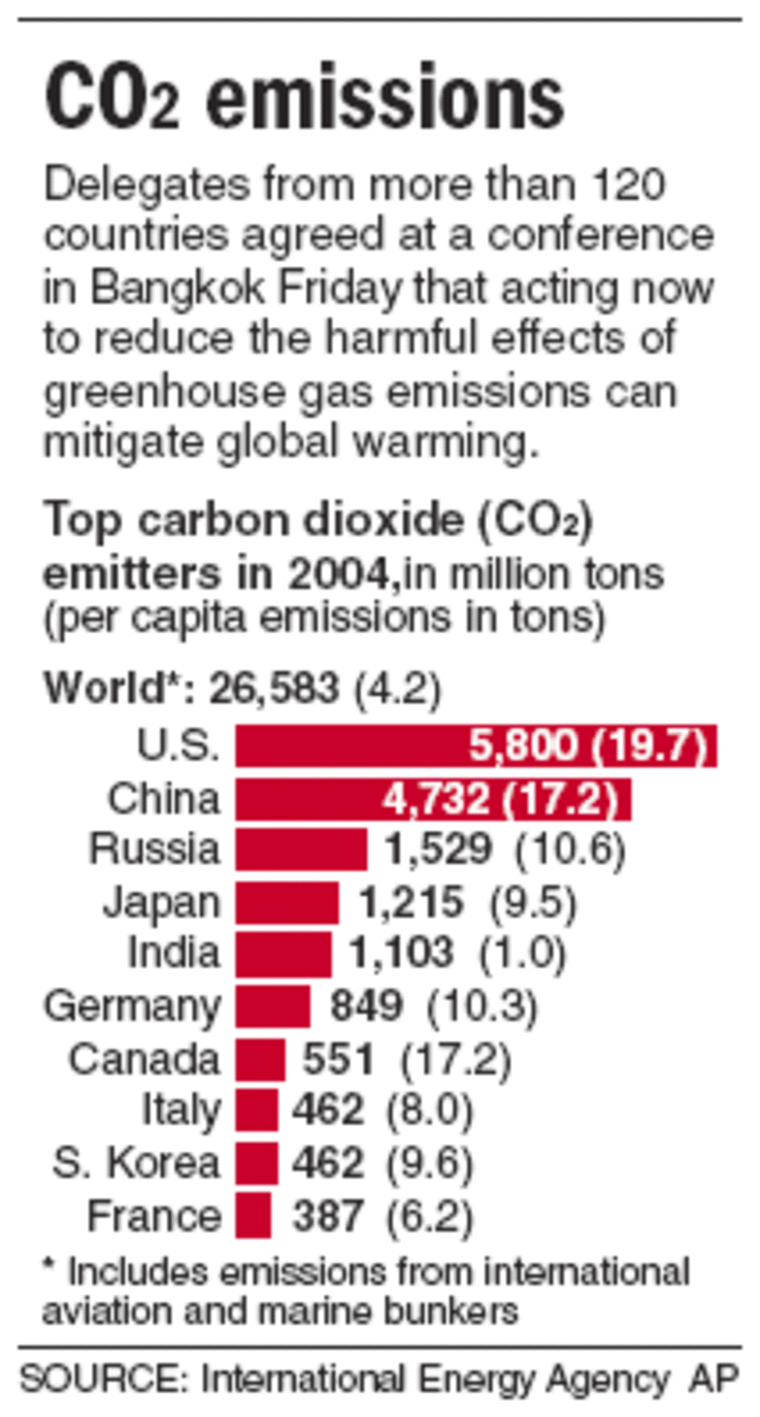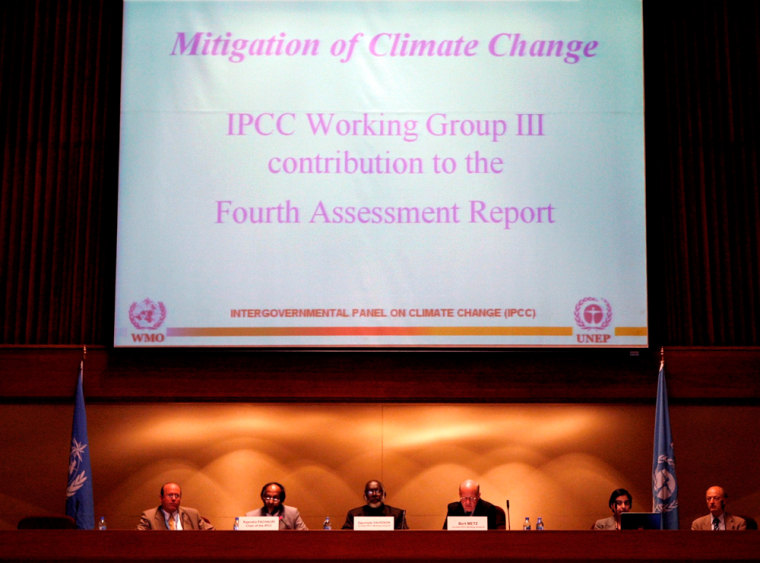Described as a road map for curbing global warming, a report was approved Friday by delegates from 120 countries that lays out what they said was an affordable arsenal of tools that must be rushed into place to avert a disastrous spike in temperatures.
But a U.S. official raised concern about the economic costs.
The report, a summary of a study by a U.N. network of 2,000 scientists, said the world has to make significant cuts in emissions through increasing the energy efficiency of buildings and vehicles, shifting from fossil fuels to renewable fuels, and reforming both the forestry and farming sectors.
The document made clear that nations have the technology and money to decisively act in time to avoid a sharp rise in temperatures that scientists say would wipe out species, raise ocean levels, wreak economic havoc and trigger droughts in some places and flooding in others.
Under the most stringent scenario, the report said the world must stabilize the amount of greenhouse gases in the atmosphere by 2015 — eight years from now — at 445 parts per million to keep global temperatures from rising more than 3.6 degrees over pre-industrial levels.
For the past year, many prominent scientists have warned that allowing greenhouse gases to surpass 450 parts per million would make dangerous climate change more likely, particularly the melting of Greenland and west Antarctic ice sheets.
'Playing with fire here'
“There are many who feel 450 parts per million is a threshold that we don’t want to go across and that we want to stabilize CO2 concentrations at that level,” said Michael Mann, director of the Earth System Science Center at Penn State University. “We’re playing with fire here.”
Going beyond 450 ppm means “there’s a good chance that we would be committed to the melt of the Greenland ice sheets. While it might take centuries, that would give us five to six (yards) of sea level rise,” Mann said, adding that would mean island nations would be lost and much of the U.S. East Coast, one-third of Florida and all of New Orleans “would be submerged.”
The biggest heat-trapping gas, carbon dioxide, is currently measured at over 380 parts per million in the atmosphere. It's sometimes trickier to measure the impact of methane and other greenhouse gases produced by industry, transport and agriculture, but they're estimated to bring the total up to about 430 ppm of "carbon dioxide equivalent."
Delegates said the approval of the report should conclusively debunk arguments by skeptics that combating global warming was too costly, that it would stifle development in poorer countries, or that the temperature rise had gone too far to change.
"If we continue doing what we are doing now, we are in deep trouble," said Ogunlade Davidson, the co-chair of group responsible for finalizing the report this week.
Delegates hailed the policy statement as a key advance toward battling global warming and setting the stage for an even stronger international agreement to replace the 1997 Kyoto Protocol on greenhouse emissions when it expires in 2012.
"It's stunning in its brilliance and relevance," Rajendra Pachauri, chair of the group responsible for the report, the U.N.-sponsored Intergovernmental Panel on Climate Change, said of the study. "It's a remarkable step forward."
"Clearly, the signs that the IPCC assess will have a direct and profound influence on the discussion that take place and the direction toward (a post-Kyoto) agreement," he said.
Bush administration view
The United States was pleased that the report "highlights the importance of a portfolio of clean energy technologies consistent with our approach," said the head of the U.S. delegation, Harlan Watson.
The report acknowledges that the 445 ppm goal is difficult, requiring all nations to deploy the best available technologies. And the U.S and Chinese delegations here complained that attempting to meet the stringent target would be too economically damaging.
"That would, of course, cause a global recession. So that is something we'd probably want to avoid," said James Connaughton, chairman of the White House Council on Environmental Quality. "Our goal is reducing emissions and growing the economy."

Coming out of the meeting, delegates said science appeared to have trumped politics — especially opposition from booming China, which felt the 445 ppm floor was too low.
Beijing, the second-largest emitter after the United States, and its supporters had argued that moves to make deep cuts in carbon dioxide emissions risked stifling its spectacular economic growth, delegates said.
Zhou Dadi, a Chinese author in the report and a researcher at the country's top planning agency, denied China had "opposed" the key findings and was only working to improve the text.
"The Chinese government was constructive and was contributing to making the report reflect the science," Zhou said. "We are not threatened by the report."
In Europe, several countries and the European Union welcomed the report.
"The report shows — and this is encouraging — that ambitious climate protection is economically manageable," German government spokesman Ulrich Wilhelm said.
At a briefing in Berlin, the U.N.'s top climate change official, Yvo de Boer, said the report "clearly rebuts fears that economic development and wealth conflict with active protection of the climate."
Delegates had wrestled over how to share the burden of cutting emissions, how much such measures would cost, and how much weight to give certain policy measures, such as advanced nuclear power, an option supported by the United States.
For many delegates, the strongest message was that reaching the lowest targets could be done at less than 3 percent of the global gross domestic product by 2030 — or 0.12 annually.
That compares favorably to global economic growth that every year has averaged almost 3 percent since 2000. The damage from unabated climate change, meanwhile, might eventually cost the global economy between 5 percent and 20 percent of GDP every year, according to a British government report last year.
"I would say it (the GDP estimates) looks like a reasonable risk to take, compared to the impact of projected climate change," said Jayant Sathaye, a scientist at the federal Lawrence Berkeley National Laboratory in California.
The report itself states that "depending on the existing tax system and spending of the revenues, modeling studies indicate that costs may be substantially lower under the assumption that revenues from carbon taxes or auctioned permits under an emission trading system are used to promote low-carbon technologies or reform of existing taxes."
Building, industrial sectors
While reducing emissions in the transportation sector might be undermined by projected growth in automobile use, the report says that buildings can easily be made to emit less carbon. "Energy efficiency options for new and existing buildings could considerably reduce CO2 emissions with net economic benefits," it states.
"The economic potential in the industrial sector is predominantly located in energy intensive industries," the report adds. "Full use of available mitigation options is not being made in either industrialized or developing nations."
Climate activists say many companies can even make money by reducing emissions. According to The Climate Group, an organization that profiled 84 companies, DuPont achieved a 60 percent reduction in greenhouse gases and $3 billion in cost savings through energy efficiency improvements.
"All of the companies profiled accrued cost savings, and over twenty achieved emissions reduction of 25 percent or higher," the group stated.
Still, there are pro-business groups, mostly in the U.S. and Australia, that insist many of the computer models on warming are unpredictable and the world has plenty of time to come up with a solution to slow greenhouse gas emissions.
“This is at a point where the science is very imperfect and there is a lot more that needs to be known,” said Alan Oxley, chairman of the Australia APEC Study Center, a free-trade think tank.
“There is not scientific certainty about this. It’s very long term,” he said. “The claims of imminent disaster are not supportable. The focus is wrong. The focus should be on creating a global consensus on reducing global emissions rather than erecting impractical and uncertain targets.”
Earlier reports
The IPCC report, which was really a "summary for policymakers" that will be followed by a longer, more technical study, follows two studies by the IPCC earlier this year warning that unabated greenhouse gas emissions could drive global temperatures up as much as 11 degrees by 2100, triggering a surge in ocean levels, destruction of vast numbers of species, economic devastation in tropical zones and mass human migrations.
Even the most stringent efforts outlined in the report, however, would not prevent suffering. An increase in temperatures to 3.6 degrees could still subject up to 2 billion people to water shortages by 2050 and threaten extinction for 20 percent to 30 percent of the world's species, the IPCC said.
Environmental groups said the report demonstrates the world can afford to battle global warming and must do so immediately.
"This is a roadmap that the IPCC is delivering," said Hans Verolme of WWF International. "It's time for the politicians to do more than just pay lip service to the issue of global warming, and to stop climate change before it's too late."
